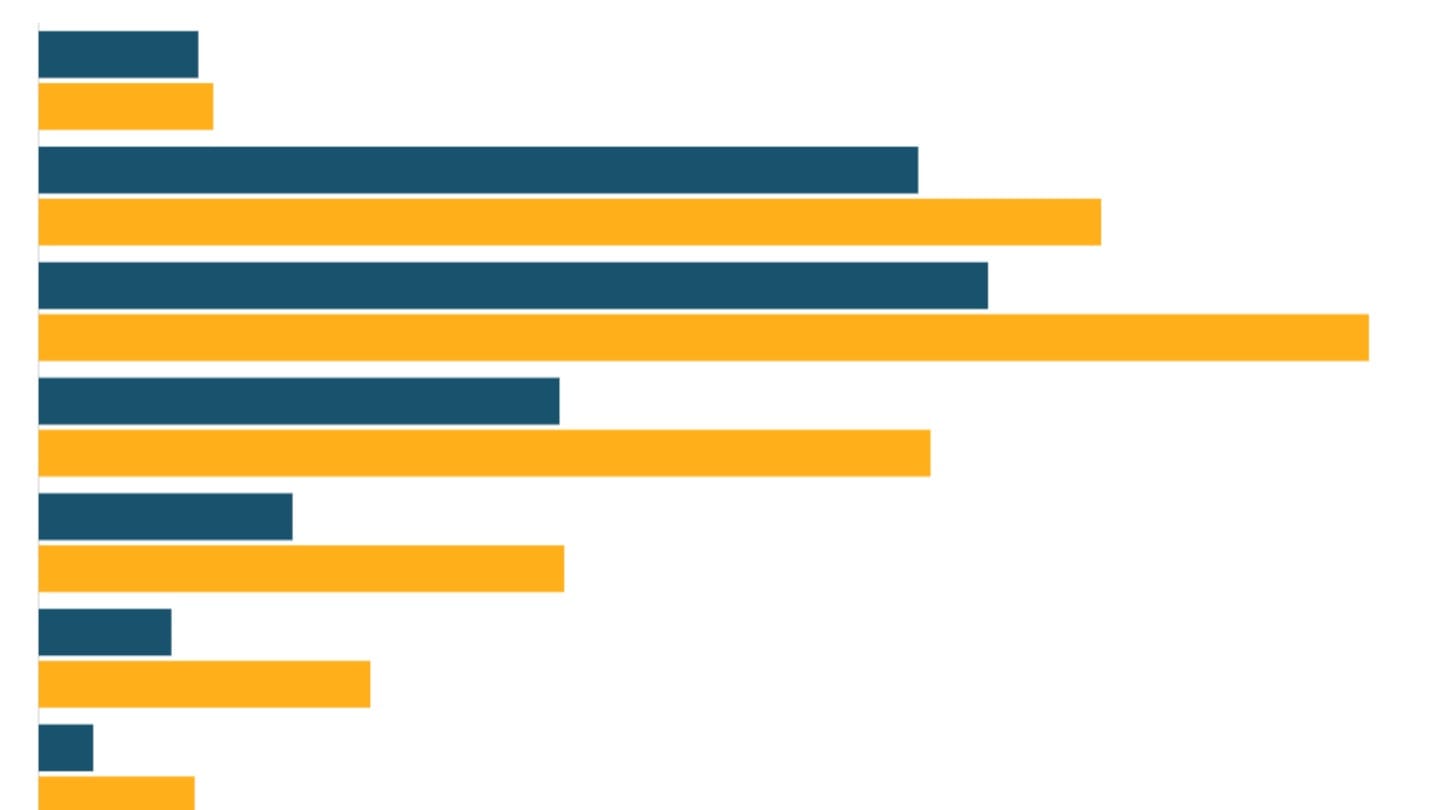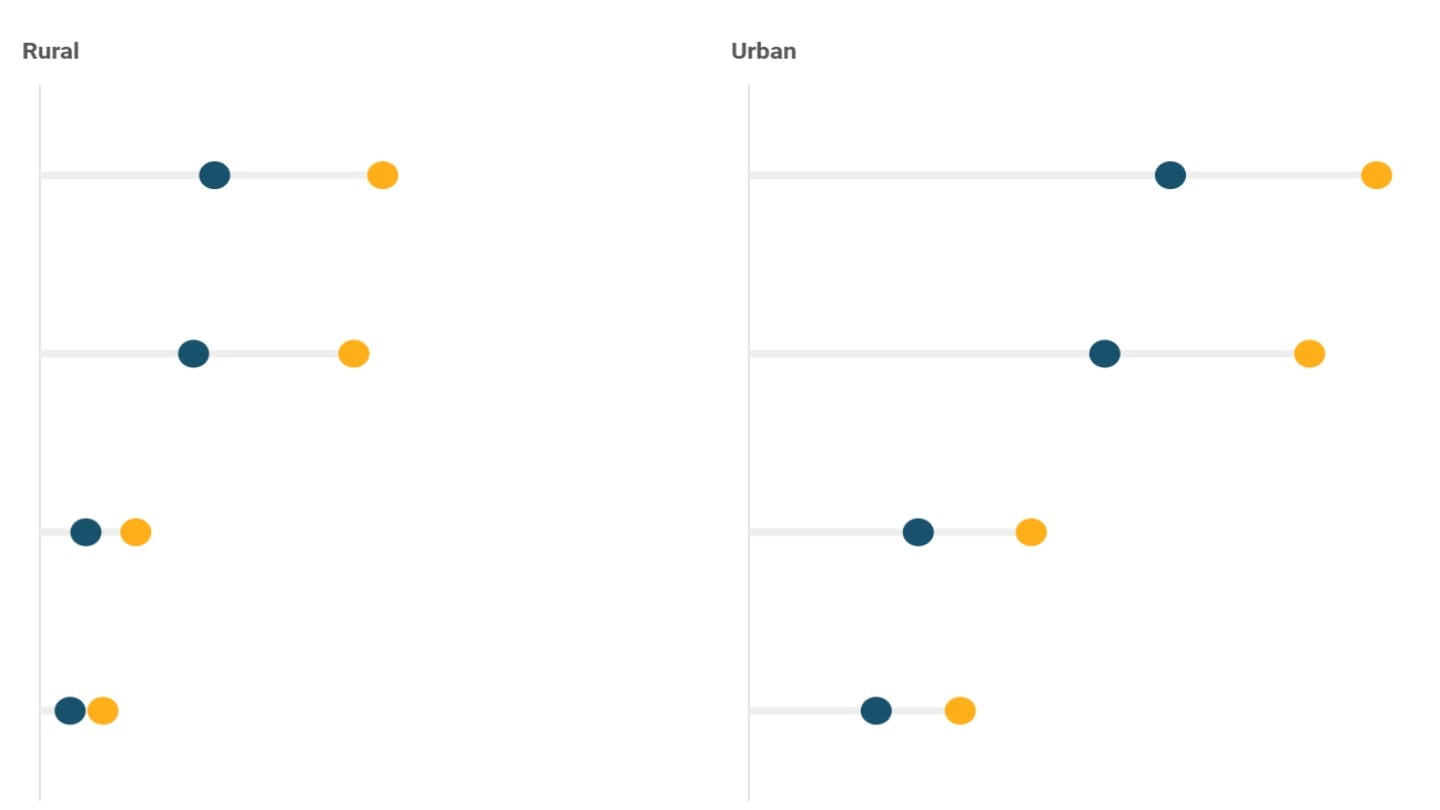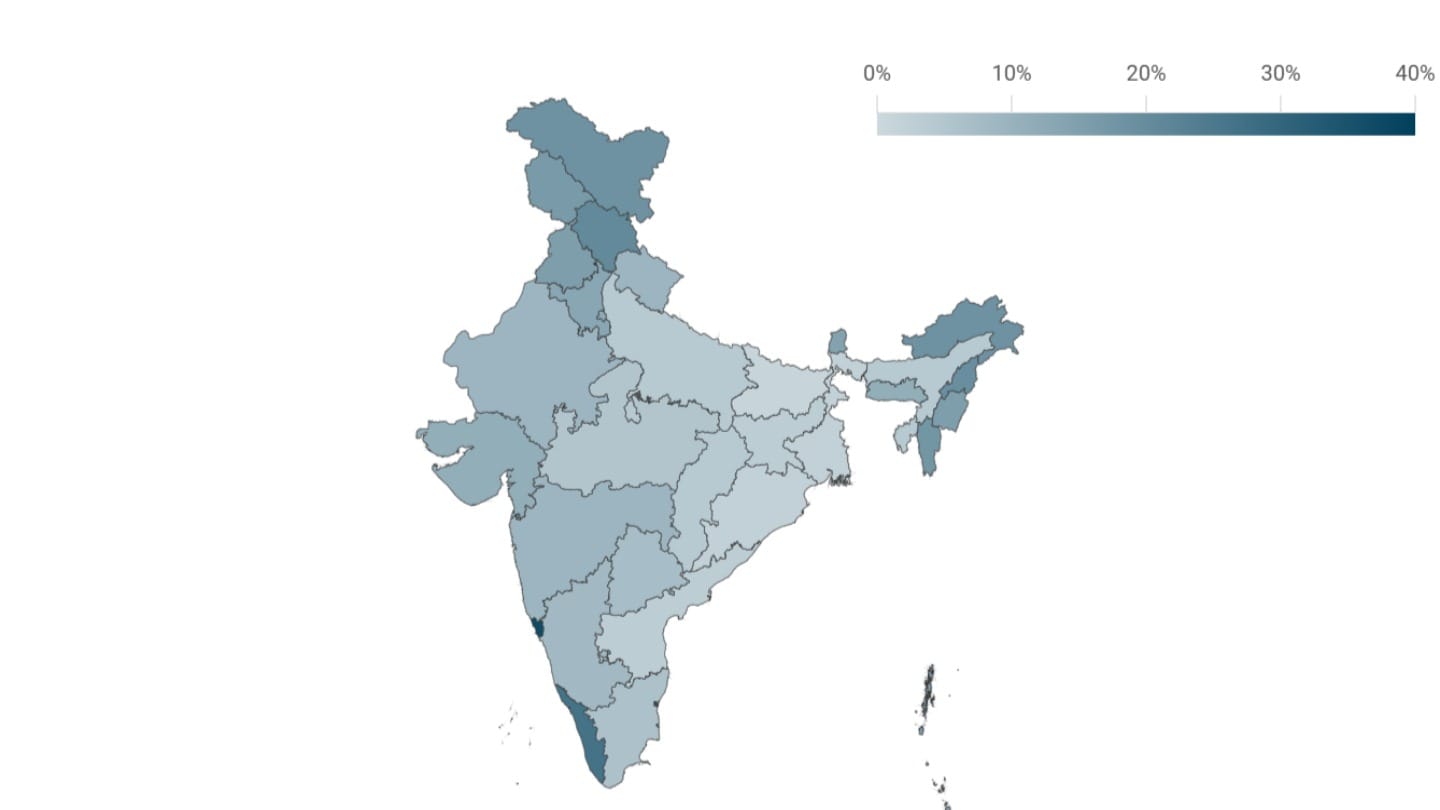Access to toilets in India
India has made major strides in improving sanitation, but one in four rural households still does not have access to toilets.
Having access to safe and usable toilet facilities is a critical component of public health and safety.
India has long struggled with very low levels of sanitation, significantly worse than many comparable countries. In 2000, only 14% of India's population had access to at least a basic sanitation facility[1] - placing it behind much poorer countries in Sub-Saharan Africa, such as Somalia. However, over the next two decades, India has made consistent progress in improving access to sanitation. By 2022, India surpassed countries that were at a similar level in 2000 or were ahead at the time.
Progress towards eliminating open defecation
When people do not have access to a safe and usable toilet, they are forced to defecate in the open.
Open defecation is a serious challenge to the dignity of individuals and to public health. Open defecation is associated with the spread of diseases like diarrhoea, cholera, and typhoid. It also exposes women and children to unsafe locations and the risk of harassment and assault. Improved sanitation is associated with long-term benefits, such as better school attendance - especially for girls, who benefit from separate, hygienic facilities - and contributes to reducing malnutrition's impact on health and development[2]. Additionally, the use of unsanitary facilities affects not only users but also sanitation workers tasked with handling waste in unsafe conditions[3].
Eliminating open defecation is a key commitment that India has made both in international fora as well as domestically. Under the United Nations' Sustainable Development Goal 6.2, India aims to provide equitable access to sanitation and hygiene for all, with a focus on women, girls, and vulnerable groups, by 2030. The Indian government's Swachh Bharat Mission (SBM), launched in 2014, aligns closely with this goal. Phase 1 of SBM targeted making India Open Defecation Free (ODF), while Phase 2, launched in 2019, focuses on solid and liquid waste management to maintain and expand sanitation levels nationwide.
The proportion of people defecating in the open dropped from 70% in 1993 to 19% by 2021, reflecting major progress. However, challenges remain, as about one in four rural households still do not have or use a toilet facility, highlighting ongoing disparities in access to sanitation.
Disparities in usage of toilets
There is a significant difference between usage of toilet facilities in rural and urban households. It is much more common in rural areas to not use a toilet facility or to use an open field for defecation. One in four rural households did not use a toilet facility as of 2021 according to data from the National Family Health Survey; in contrast, only 6% reported the same in urban households[4].
Bihar has the highest share of households not using any toilet facility at nearly 40%, followed by Jharkhand and Odisha, where around one in three households do not use toilets. In Madhya Pradesh, Uttar Pradesh, Tamil Nadu, and Rajasthan, more than one in five households also report not using a toilet. Kerala and the north-eastern states consistently report high levels of toilet usage.
Over half the Indian households that are forced to defecate in the open reside in four states - Uttar Pradesh, Bihar, Maharashtra, Tamil Nadu.
Nine in ten households that do not use a toilet facility are located in rural areas. Half of the households that do not use a toilet fall within the poorest wealth quintile. In urban areas, this disparity is sharper - 84% of households that do not use a toilet belong to the poorest wealth quintile.
Types of toilet facilities
In India, toilet facilities are categorised into several types. The most sanitary is the flush/pour-flush type[5], which uses water to transport waste from the facility to a septic tank, sewer system, or pit. Pit latrines[6], which are dry, come next, though they vary widely in terms of hygiene. Other less common types include composting toilets[7] and service latrines[8].
In urban areas, flush toilets are the predominant type, used by nearly nine in ten households, while in rural areas, around six in ten households use such toilets.
In addition to toilet types, exclusive access to facilities is crucial for sanitation quality. Under the SDG target 6.2, facilities shared with other households are classified as a "limited" sanitation service.
While urban households generally have better access to improved toilets, shared usage is more common - 12% of urban households share toilet facilities. Among the poorest urban households, about one in three rely on shared facilities. Furthermore, the extent of sharing is higher in urban settings, where over half of shared facilities are used by three or more households, and 16% serve ten or more, indicating a greater density of shared sanitation in urban settings. In rural areas, on the other hand, shared facilities are less common, even among low-income households.
Access versus usage
National surveys like the National Family Health Survey (NFHS) and various National Sample Survey (NSS) rounds measure access to sanitation by asking detailed questions about toilet facilities. Both surveys assess access at the household level, meaning questions are directed to households as a whole rather than to individual members.
The NSS investigates access to sanitation, through its various surveys over the years, such as the Household Consumer Expenditure Survey (HCES), the Drinking Water, Sanitation, Hygiene And Housing Condition Survey and Housing Condition Survey. However, the focus is primarily on access to facilities (having a toilet) rather than usage (using a toilet).
The NFHS by the International Institute of Population Sciences (IIPS) conducts nationally representative household surveys; the latest iteration in 2019-21 was across 637,000 households nationwide. The survey includes a set of questions to understand the types of toilet facilities used by household members. It records whether the facilities are shared or exclusively used by a household, and if shared, how many other households share the facility.
For respondents who indicate they do not use a toilet, further questions explore whether they have access to one, even if not in use. Most people who do not use a toilet also do not have access to it. However, about one in ten households that do not use a toilet facility report that this is despite them having access to one, a pattern especially noticeable in urban areas where three in ten households that do not use a toilet facility reported that they do have access to it. (The survey does not ask the reasons for not using it.)
[1] The Joint Monitoring Programme of the World Health Organization (WHO) and United Nations Children's Fund (UNICEF) defines basic sanitation facilities as improved sanitation facilities that are not shared with other households. Improved sanitation facilities include flush/pour flush to piped sewer systems, septic tanks or pit latrines; ventilated improved pit latrines, composting toilets or pit latrines with slabs.
[3] Manual Scavenging report, Dr. Babasaheb Ambedkar Research and Training Institute
[4] For more details on the data source and methodology, see the last section of this article
[5] A flush latrine uses a tank to release water and a water seal to block flies and odours. A pour-flush latrine also has a water seal but requires water to be poured by hand, as it doesn't use a tank. These facilities connect to sewer systems, septic tanks, or pit latrines to safely transport waste away from homes. They qualify as improved sanitation, as they effectively separate waste, creating a cleaner and healthier environment.
[6] Pit latrines are dry toilets that use a ground hole to collect waste. The most common type - 3 in 4 facilities - includes a raised squatting slab or platform supported on all sides to prevent water from entering. However, about 15% lack a slab, especially in rural areas where simpler structures are more common. About 10% households use Ventilated Improved Pit (VIP) latrines, which have a ventilation pipe extending above the roof to reduce odours and insects.
[7] Composting toilets are dry and eco-friendly, using aerobic decomposition to convert waste into compost. Carbon-rich materials like straw, sawdust, or ash are added to support the composting process.
[8] Service latrines depend on periodic manual removal of waste.




